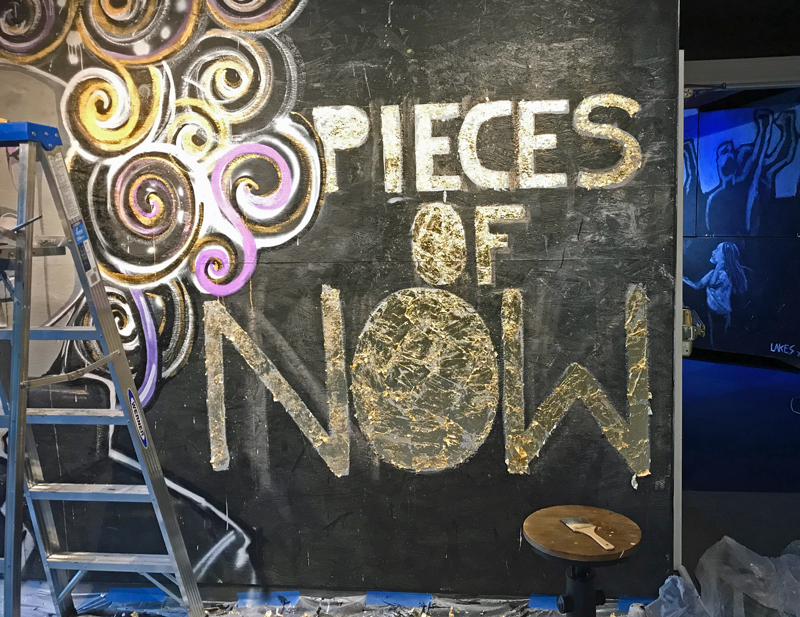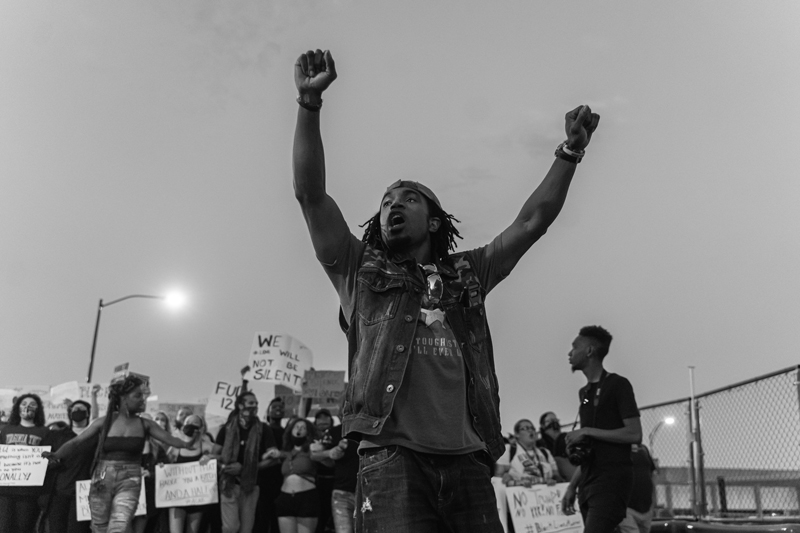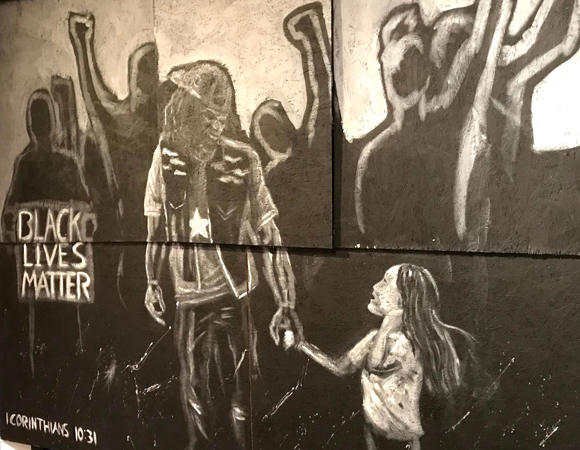September 26, 2020–November 28, 2021
Winner of History in Progress Award from the American Association of State & Local History, 2021; Gold Award in Research & Innovation, Silver Award for 2020 Response, Media & Technology MUSE Awards from the American Alliance of Museums, 2021
Together let’s preserve the history of 2020 – and start to make sense of it
From face masks to S. Elm Street storefront murals demanding racial justice, 2020 has seen amazing expressions across the Gate City. Pieces of Now displays some of these objects, including nearly 20 pieces of street art created as part of the summer’s Black Lives Matter protests. The exhibition also invites the community to share experiences, stories and objects related to the protests, pandemic and economic crisis.
To see more and experience the online exhibition, go to greensborohm.wpengine.com/piecesofnow
Want to contribute your story from 2020? Learn how at greensborohm.wpengine.com/history-now
December 7, 2019 – March 29, 2020
What happens when a people decide to govern themselves? America’s national treasures come to life in this compelling exhibition that examines the bold experiment to create a government “of the people, by the people, and for the people.”

Congress of Racial Equality (CORE) organizing pamphlet, 1960s Courtesy of National Museum of American History
The Smithsonian traveling exhibition American Democracy: A Great Leap of Faith explores the history of citizen participation, debate, and compromise from the nation’s formation to today. The exhibition focuses on the changing political ideals and principles of the nation, citizenship in a pluralistic society, and political participation and engagement.
A Great Leap of Faith
In 1776, British colonists in America revolted to change their world to a government based on the people. The identity of “the people” has been debated ever since. We are still on a journey to make a more perfect union, but we must all take active roles in this great American democracy.
A Vote, A Voice
The Founders never imagined the diverse body of voters we have today. They still envisioned that a limited body of propertied white men would vote on behalf of everyone. The fight for fair representation, suffrage, and a voice at the polls has meant struggle and changes to laws ever since.
The Machinery of Democracy
We often participate in the political system through informal institutions including state and national parties, nomination and ratification conventions, and political campaigns. This machinery of democracy engages the citizenry and often controls how we get our information about candidates and issues.
Beyond the Ballot
Our Constitutional First Amendment right is that of the people to peaceably assemble and to petition the Government for a redress of grievances. In different places, and with different resources, diverse groups of Americans have petitioned for their interests and concerns.
Creating Citizens
How do we define “We, the People”? What is the meaning of citizenship? Who is a citizen and what are their rights and responsibilities? We have continued to shape our diverse national identity by understanding our rights and responsibilities and by exploring our complex national story.
American Democracy: A Great Leap of Faith is the centerpiece of Project Democracy 20/20, a major initiative exploring American democracy through exhibitions, public programs and innovative community connections. Click here to learn more about Project Democracy 20/20
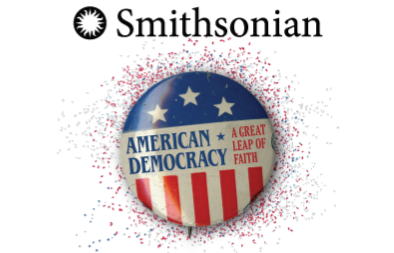
American Democracy: A Great Leap of Faith was developed by the National Museum of American History and adapted for travel by the Smithsonian Institution Traveling Exhibition Service
May 18, 2018 – September 22, 2019
type-WRITE invites visitors to put fingers to keys and have fun.
 View typewriters belonging to UNCG pioneer Joanne Smart Drane and to Greensboro writers Smith Barrier, Marianne Gingher and others. And have you ever seen a coin-operated typewriter? The one on display from the Hotel Guilford even features a rotating display of advertising cards from early 20th-century Greensboro.
View typewriters belonging to UNCG pioneer Joanne Smart Drane and to Greensboro writers Smith Barrier, Marianne Gingher and others. And have you ever seen a coin-operated typewriter? The one on display from the Hotel Guilford even features a rotating display of advertising cards from early 20th-century Greensboro.
Come learn about these fascinating machines and try out some vintage typewriters yourself.
November 11, 2017 – August 18, 2019
We may be better or worse — but we are not the same. Since the World War began, we have changed. Are you better or worse? You are not the same.
—Private Felix E. Brockmann of Greensboro, Ambulance Co. No. 321
 A century ago, a Great War changed Greensboro and the world. It also changed nine lives. Lest We Forget: WWI through the Eyes of Nine looks at how our city experienced and continues to remember World War I.
A century ago, a Great War changed Greensboro and the world. It also changed nine lives. Lest We Forget: WWI through the Eyes of Nine looks at how our city experienced and continues to remember World War I.
Lest We Forget invites visitors to turn pages to learn about nine individuals connected by the Great War but whose experiences were very different. Through the stories of Maceo Alston, John Bean, Robert Campbell, Harriet Elliott, Margaret Falkener, Mary Mendenhall Hobbs, Malvin Johnson, Dorothy Hayden Conyers and C. M. Vanstory, visitors learn how the war affected people at home and abroad. The exhibit also includes glimpses into local volunteer companies, the Red Cross, the 1918 influenza outbreak and more.
Resources
View Sailors, Nurses, Sailors of Guilford County in the World War scrapbook, Vol. I and Vol. II, online at Textiles, Teachers and Troops: Greensboro, North Carolina, 1880-1945
World War I at North Carolina Digital Collections
June 1, 2017 – February 3, 2019
What was your family’s journey to America? The echoes of those journeys can be heard across the generations and seen in the children of children. This exhibition shares stories of identity, stereotypes and family, told from the viewpoints of Greensboro natives of Asian heritage. It is also a recognition and an appreciation of their ancestors. The exhibition is also proud to feature video clips and objects provided by Ken Jeong and Sony Studios from Ken’s TV show, Dr. Ken.
I think everybody in our country should remember that most of us are immigrants. You might have immigrated earlier than someone else, but we all came from different places. That’s a really positive thing. That’s something the United States has always prided itself in, the whole mosaic coming together.
–Tiffany Lam-Balfour
I think as 2nd and 3rd generation immigrants, identity is in our heads. We’re Americans!
–Uma Avva
My mom’s always cooking. And when my grandmother is in town, she’s always cooking because that’s a huge way they show their love. So regardless if they hug you or say they love you, when they cook for you it’s a sign of them caring for you.
–Jennifer Leung
November 7, 1999 – June 4, 2017
Please note: A new exhibit based around this collection opened in a smaller gallery in 2019.
No culture is without war or the weapons that carry out that conflict. 1861 through 1865 were some of the most trying times for our region and our nation, as the Civil War ripped apart the United States of America and the lives of so many families.
The John and Isabelle Murphy Confederate Firearms Collection is a must for those interested in the distinctive style of these antique firearms. It features over 150 fine examples of longarms from every major Confederate armory. For those who crave works of art, the exhibit includes contemporary paintings by Don Troiani, and is supplemented by Civil War artifacts from our permanent collection.
May 21, 2016 – April 23, 2017
What the heck is that?
Greensboro’s history inspired artist Janet Echelman to create something of wonder for LeBauer Park.
This exhibition centers on the massive aerial artwork that Janet Echelman designed for the Carolyn & Maurice LeBauer Park. Inspired by the threads of our local history, Echelman wove an ever-changing sculpture, 90 feet by 70 feet, that hangs 55 feet in the air. The exhibition also explores the ways history can inspire art and audience.
Our second floor gallery space has been transformed ─ new carpet, curvilinear wall system and video installations ─ so you experience history at the museum as never before. An original film features an interview with Janet Echelman about her Greensboro sculpture. Visitors are able to play with ideas of history and art, weaving their own wonder. Elements of the exhibit include two interactives: an interactive map kiosk of Greensboro public art and a station where visitors create their own Ah-Ha! moment and art inspired by Greensboro’s history.
September 24, 2016 – February 26, 2017
Asian and Pacific Americans make up more than 5% of the U.S. population—more than 17 million people—and those numbers are growing. Their ancestral roots represent more than 50% of the world, extending from East Asia to Southeast Asia, and from South Asia to the Pacific Islands and Polynesia. Among our Greensboro neighbors are more than 20,000 people with ties to this region.
I Want the Wide American Earth, the title of which comes from a stirring poem by Filipino immigrant, poet and labor activist Carlos Bulosan (1913-1956), was created by the Smithsonian Asian Pacific American Center and the Smithsonian Institution Traveling Exhibition Service (SITES). The exhibition is supported by a grant from the W.K. Kellogg Foundation.
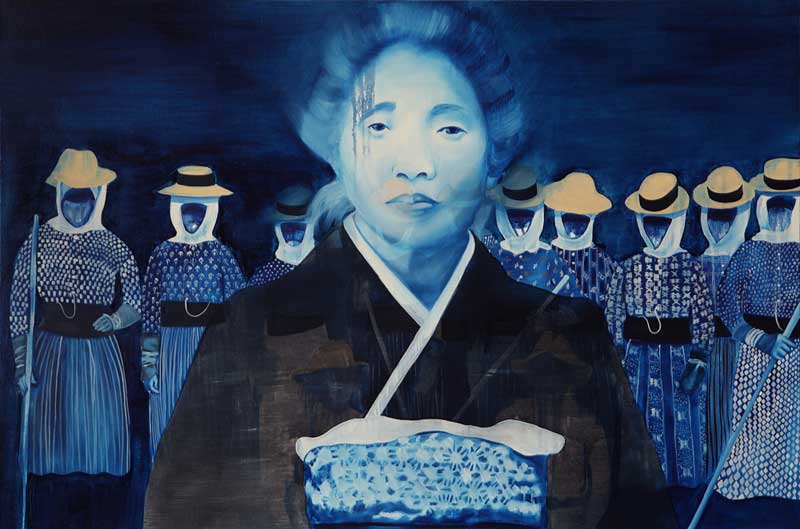 In this first exhibition of its kind, the Smithsonian celebrates Asian Pacific American history across a multitude of diverse cultures and explores how Asian Pacific Americans have shaped and been shaped by the course of the nation’s history. I Want the Wide American Earth tells the rich and complex stories of the very first Asian immigrants, including their participation in key moments in American history: Asian immigrants panned in the Gold Rush, hammered ties in the Transcontinental Railroad, fought on both sides in the Civil War and helped build the nation’s agricultural system.
In this first exhibition of its kind, the Smithsonian celebrates Asian Pacific American history across a multitude of diverse cultures and explores how Asian Pacific Americans have shaped and been shaped by the course of the nation’s history. I Want the Wide American Earth tells the rich and complex stories of the very first Asian immigrants, including their participation in key moments in American history: Asian immigrants panned in the Gold Rush, hammered ties in the Transcontinental Railroad, fought on both sides in the Civil War and helped build the nation’s agricultural system.
Through the decades, Asian immigrants struggled against legal exclusion, civil rights violations and unlawful detention, such as the 120,000 Japanese who were interred during World War II. Since the 1960s, vibrant new communities, Pan Asian, Pacific Islander and cross-cultural in make-up, have blossomed.
Curated by Lawrence-Ming Bùi Davis, Smithsonian Asian Pacific American Center Initiative Coordinator, I Want the Wide American Earth is a moving, dramatic and evocative narrative of Asian Pacific American history and culture.
Generations: Voices of Greensboro’s Asian Pacific Families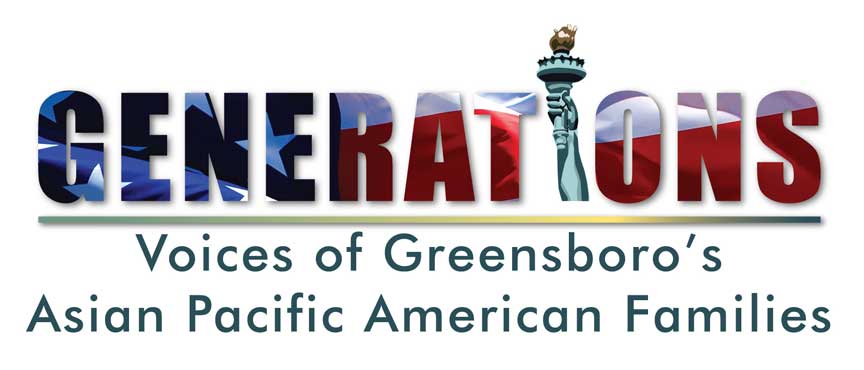
This local display, supplementing the banners of I Want the Wide American Earth, brings forward the stories of our neighbors. Visitors will see family treasures, photographs and oral history interviews, made possible with the support of many individuals and organizations and a volunteer Community Advisory Board. An original film features selections from interviews with people with ties to Asian Pacific nations and cultures, including India, Korea, China, Thailand, Cambodia, Philippines, Pakistan, Taiwan, Laos, Singapore, Vietnam, Hmong, Montagnard, Malaysia and Japan.
